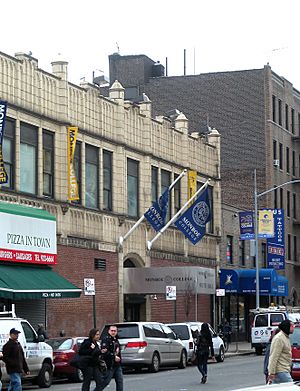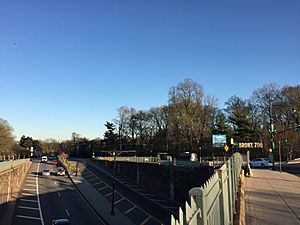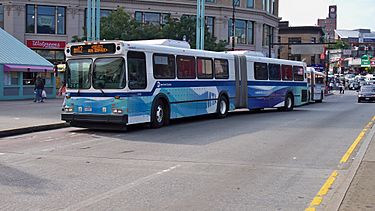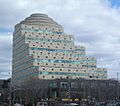Fordham, Bronx facts for kids
Quick facts for kids
Fordham Manor
|
|
|---|---|
|
Neighborhood of the Bronx
|
|

Looking south across Fordham Road and along Walton Avenue at Monroe College
|
|
| Country | |
| State | |
| City | |
| Borough | |
| Community District | The Bronx 5 and The Bronx 7 |
| Area | |
| • Total | 0.507 sq mi (1.31 km2) |
| Population
(2011)
|
|
| • Total | 43,394 |
| • Density | 85,590/sq mi (33,050/km2) |
| Economics | |
| • Median income | $26,143 |
| ZIP Codes |
10453, 10457, 10458, 10468
|
| Area code | 718, 347, 929, and 917 |
Fordham Manor is a lively neighborhood in the western part of Bronx, New York City. It is bordered by East 196th Street to the north, the Harlem River to the west, Fordham Road to the south, and Southern Boulevard to the east. The main streets in Fordham are Fordham Road and Grand Concourse.
Fordham Manor is part of two local community districts: Bronx Community Board 5 and Bronx Community Board 7. Its ZIP Codes include 10453, 10457, 10458, and 10468. You can get around Fordham using the subway lines like the IND Concourse Line (B D trains) and the IRT Jerome Avenue Line (4 train). The neighborhood is kept safe by the New York City Police Department's 46th Precinct. Fordham is also home to the original campus of Fordham University.
Contents
Fordham's Past: A Look Back
Jan Arcer, a Dutch settler, started a community here in 1666. He later changed his name to John Archer. Archer owned a large area of land, about 3,900 acres. The colonial governor of New York, Francis Lovelace, approved this settlement.
This area was known as "Fordham Manor" and covered about 6 square miles. Archer became the "Lord of the Manor." Sixteen families set up farms in the area. The Manor existed from 1671 to 1762.
Archer named his community Fordham. This name might have come from a shallow river crossing, or "ford," nearby. It could also have been named after John Fordham, an English priest from the 1300s.
Old Fordham Village: Early Days
Old Fordham Village is a historic part of Fordham. It dates back to when the English ruled the area. This village is located where the Grand Concourse and Fordham Road meet. It stretches north to 196th Street, south to 187th Street, east to Southern Boulevard, and west to Jerome Avenue.
The village started around 1751 when Fordham Manor was built on a place called Rose Hill. Most of this old estate is now part of the Rose Hill Campus of Fordham University. Besides the university buildings, some other historic homes are still in Old Fordham Village. For example, the famous American poet Edgar Allan Poe lived his last years here. His cottage is still standing in Poe Park. The Fordham University Church bell, named "old Edgar," might have inspired his poem, "The Bells."
In the 1700s, the Kings Road passed through Old Fordham Village. This road connected Colonial New York with towns further north, like Boston. It was a small resting spot for travelers. During the American Revolution, this area was important for Gen. George Washington's army. They used it to escape from New York while being chased by British forces. Many American Patriots lived here. After the war, Kings Road became the Boston Post Road.
In the 1800s, Old Fordham Village began to grow. This happened when the White Plains Line, later the Harlem Line railroad, was built. Farmers could now send their products to New York City by train. A large pond and ice house were built north of the village. They provided fresh ice for the community and the railroad.
In 1838, Andrew Carrigan, a wealthy Irish Catholic businessman, bought the 100-acre Rose Hill estate. He sold it to his friend John Joseph Hughes, a bishop. Hughes founded St. Joseph's Seminary (1840) and St. Joseph's College (1841) on the property. This college later became Fordham University.
West of the village, the Bathgate Estate was built. Later, Leonard Jerome, a wealthy stock speculator, bought it. He built the Jerome Park Racetrack there. The first Belmont Stakes race was held at this track.
Fordham After 1900
Fordham remained mostly rural until around 1900. Then, New York City began to grow rapidly. New public transportation made it easier to travel to the suburbs. Old Fordham Village and the surrounding areas became part of the Bronx borough within New York City.
Many farms and estates were sold to builders. They built houses and large apartment buildings. The quiet village quickly became a major business and transportation center. The Boston Post Road was renamed Fordham Road in this area. It became part of U.S. Route 1 in 1926.
From the 1920s to the late 1970s, Fordham was mainly a middle class neighborhood. Many families were of Irish and Jewish backgrounds. Later, many families moved to the suburbs or to places like Florida. Today, Fordham is mostly home to Latino American and African American residents. There are also many Italian and Albanian people.
Fordham's People: Demographics
Fordham has a population of about 43,394 people. The neighborhood first grew in the 1920s. At that time, middle-class and working-class families moved here from Manhattan. They liked the new housing and easy subway access to jobs and shops in Manhattan.
Today, Fordham is mainly Latino American and African American. There are also many people of Italian and Albanian heritage.
Fordham is split into two parts for community planning. Community District 5 is south of Fordham Road, called Fordham South. Community District 7 is north of Fordham Road, called Fordham North. In both areas, most residents are young people and middle-aged adults. About 28% are between 0–17 years old, and 29% are between 25 and 44.
In 2017, the average household income in Fordham South was about $30,166. In Fordham North, it was about $35,355. In 2018, about 34% of people in Fordham South lived in poverty. This means they had a hard time making enough money. In Fordham North, about 26% lived in poverty.
Many residents in Fordham also spend a large part of their income on rent. About 65% of people in Fordham South and 61% in Fordham North have trouble paying their rent.
Fordham's Landscape and Buildings
Fordham is mostly filled with 5- and 6-story apartment buildings. Many of these buildings are built right up to the sidewalk. The apartments along the Grand Concourse are even taller.
Two large green spaces are located within the neighborhood. The New York Botanical Garden and the Wildlife Conservation Society's Bronx Zoo are both inside Bronx Park. They cover many acres of land.
Fordham University has its historic campus here. It is built on much of the old Rose Hill Manor. It is one of the largest "green" campuses in New York City. Its old-style buildings are often used as backdrops for TV shows and movies.
The Fordham Road Business Improvement District is on the northern edge of the neighborhood. This shopping area is the longest in the Bronx.
Fordham is divided into two community districts. Community District 5 covers southern Fordham South. Community District 7 includes Fordham North and Bedford Park. In 2018, Community District 5 had about 136,151 residents. Community District 7 had about 148,163 residents. The average life expectancy in both areas is around 79 years.
Fire Safety in Fordham
Fordham has two New York City Fire Department (FDNY) fire stations. Engine Co. 48/Ladder Co. 56/Division 7 is located at 2417 Webster Avenue. Engine Co. 75/Ladder Co. 33/Battalion 19 is at 2175 Walton Avenue. These stations help keep the community safe.
Mail and ZIP Codes
Fordham is divided into four ZIP Codes. These are 10453, 10457, 10458, and 10468. The United States Postal Service has a post office called Jerome Station at 2549 Jerome Avenue.
Learning in Fordham: Education
Fordham generally has fewer college-educated residents compared to the rest of New York City. In Fordham South, about 10% of adults aged 25 and older have a college degree. In Fordham North, this number is 23%.
However, students in Fordham are improving in school. The percentage of Fordham South students doing well in math rose from 19% in 2000 to 43% in 2011. Reading skills also improved. In Fordham North, math success went from 21% to 48% in the same period.
Elementary school students in Fordham tend to miss more school days than the city average. About 30% of elementary students in Fordham South miss twenty or more days per school year. In Fordham North, it's 28%. For high school students, about 66% in Fordham South and 70% in Fordham North graduate on time. This is a bit lower than the city average.
Schools in Fordham
Fordham has several public elementary schools:
- PS 33 Timothy Dwight (grades PK–5)
- PS/IS 54 (grades PK–5)
- PS 159 Luis Muñoz Marin Biling (grades K–5)
- PS 246 Poe Center (grades K–5)
Public middle schools serving grades 6–8 include:
- Academy for Personal Leadership and Excellence
- Jonas Bronck Academy
The Rose Hill campus of Fordham University is located in Fordham. It is the university's oldest campus. It includes Fordham College at Rose Hill, the Gabelli School of Business, and other graduate schools.
Monroe College, a private college, has been in Fordham since 1967. It is close to the Fordham shopping area.
Fordham's Library
The New York Public Library (NYPL) operates the Bronx Library Center at 310 East Kingsbridge Road. This library opened in 2006. It is the largest NYPL branch in the Bronx.
Getting Around Fordham: Transportation
Fordham has subway and train services.
- Fordham Road station (4 train)
- Kingsbridge Road station (4 train)
- 182nd–183rd Streets (B and D train)
- Fordham Road station (B D trains)
- Fordham Station (Metro-North)
Many MTA Regional Bus Operations bus routes also serve Fordham:
- Bx1: Travels along Grand Concourse.
- Bx2: Also travels along Grand Concourse.
- Bx3: Goes via University Avenue.
- Bx9: Travels along Kingsbridge Road.
- Bx12 (Including Select Bus Service): Travels along Fordham Road–Pelham Parkway.
- Bx15: Goes via Third Avenue.
- Bx19: Travels via Southern Boulevard & East 149th Street.
- Bx17: Goes via Prospect-Crotona Avenues.
- Bx22: Travels via Castle Hill Avenue.
- Bx28: Goes via Gun Hill Road.
- Bx34: Travels via Bainbridge Avenue.
- Bx38: Goes via Gun Hill Road (Sunday nights only).
- Bx41 (Including Select Bus Service): Travels via Webster Avenue.
Fordham is also served by Bee-Line Bus System routes that connect to Westchester County, New York:
- BL60: To White Plains, New York (via Boston Road).
- BL61: To Port Chester, New York (via Boston Road).
- BL62: To White Plains, New York (via Boston Road).
Images for kids
-
Fordham near New York Botanical Garden and the Bronx Zoo






